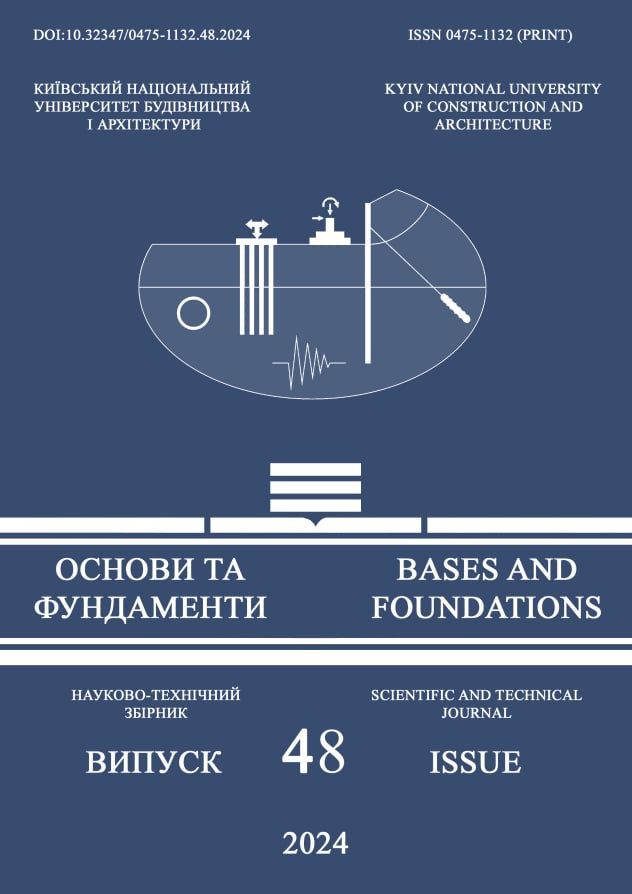Геотехнічні питання дослідження технічного стану споруди на слабких ґрунтах за методом граничних елементів
Основний зміст сторінки статті
Анотація
Розглянуто дискусійне питання необхідності врахування підвищувального коефіцієнта до модуля деформацій ґрунту, отриманого на базі компресійних досліджень для проектування лесових замоклих ґрунтів. Як відомо слабкі ґрунти можуть мати низьку несучу здатність та високу стисливість, що робить їх складними для будівництва та експлуатації споруд.
Відомо, що в лабораторних умовах модуль деформації ґрунту зазвичай визначають його ущільненням статичним навантаженням без можливості бічного розширення у жорсткому кільці. Недолік компресійного приладу є невисока точність вимірів підкреслена багатьма дослідниками через те, що сили тертя зразка ґрунту по стінках кільця зменшують в залежності від вологості і виду ґрунту вертикальний тиск, прикладений до зразка під час випробування. Це призводить до хибного зменшення фактичного значення модуля деформацій ґрунту.
Для визначення достовірності двох підходів по визначенню модуля деформацій ґрунту, проведено розрахунки осідань фундаментів силосів зерносховищ на небезпечних деградованих лесових ґрунтах за числовим методом граничних елементів (МГЕ) з використанням пружно-пластичної моделі, у варіанті врахування до модуля деформацій ґрунту підвищувального коефіцієнта та без урахування його.
Виявлено, що вирішення задач оцінки технічного стану будівлі пов’язані з геодезичними та інженерно-геологічними вишукуваннями та з аналізом цих результатів, оскільки саме від них залежить напружено-деформований стан системи “будівля-основа” та особливості деформування ґрунтової основи. Адже проблема пов’язана із захистом споруди від крену є досить актуальною. Проектування або реконструкція споруд на основах із слабкими ґрунтами (з модулем деформацій Е < 5 МПа) теж пов’язано з проблемою забезпечення не перевищення розрахунковими значеннями деформацій їх гранично допустимих величин для дослідної споруди.
Результати числових досліджень порівняно з розрахунком за методом скінченних елементів (МСЕ) та експериментом.
Блок інформації про статтю

Ця робота ліцензується відповідно до Creative Commons Attribution 4.0 International License.
Автори, які публікуються у цьому журналі, погоджуються з наступними умовами: Автори залишають за собою право на авторство своєї роботи та передають журналу право першої публікації цієї роботи на умовах ліцензії Creative Commons Attribution License, котра дозволяє іншим особам вільно розповсюджувати опубліковану роботу з обов'язковим посиланням на авторів оригінальної роботи та першу публікацію роботи у цьому журналі. Автори мають право укладати самостійні додаткові угоди щодо неексклюзивного розповсюдження роботи у тому вигляді, в якому вона була опублікована цим журналом (наприклад, розміщувати роботу в електронному сховищі установи або публікувати у складі монографії), за умови збереження посилання на першу публікацію роботи у цьому журналі. Політика журналу дозволяє і заохочує розміщення авторами в мережі Інтернет (наприклад, у сховищах установ або на особистих веб-сайтах) рукопису роботи, як до подання цього рукопису до редакції, так і під час його редакційного опрацювання, оскільки це сприяє виникненню продуктивної наукової дискусії та позитивно позначається на оперативності та динаміці цитування опублікованої роботи (див. The Effect of Open Access).Посилання
Brebbia C.A. Boundary Element Techniques: Theory and Applications in Engineering / C.A. Brebbia, J.C.F. Telles, L.C. Wrobel. — Berlin and New York: Springer-Verlag, 1984. — 464 р.
Бойко І.П. Напружено-деформований стан ґрунтового масиву при побудові нових фундаментів поблизу існуючих будинків / І.П. Бойко, О.В. Сахаров // Основи і фун-даменти: Міжвідомчий науково-технічний збірник. – К. : КНУБА, 2004. – Вип. 28. – С. 3-10.
Моргун А.С. Нелінійні проблеми механіки ґрунтів /А.С. Моргун // Вінниця, ВНТУ, 2016. – 122 с.
Ніколаєвський В.Н. Сучасні проблеми ме-ханіки грунтів / В.Н. Ніколаєвський // Ви-значальні закони механіки грунтів. 1975. – С. 210-227.
Червінський Я.Й. Дослідження технічного стану будівель та споруд при небезпечних геологічних процесах / Я.Й. Червінський, О.О. Петраков, М.Л. Зоценко, Ю.Л. Вин-ников, В.А. Титаренко, В.Д. Шумінський, С.В. Степанчук, А.М. Дворник, Я.І. Домб-ровський // Наука та будівництво. – К.: ДП НДІБК, – 2014. – С. 17-24.
Горбунов В. П. О современных тенден-циях в развитии механики грунтов. Дис-куссии. / В. П. Горбунов // ОФиМГ. – 1979. – № 1 С. 26-27.
Brebbia C.A., Telles J.C.F., Wrobel L.C. (1984). Boundary Element Techniques: Theory and Applications in Engineering. Berlin and New York: Springer-Verlag
Boiko I.P., Sakharov O.V. (2004). Napru-zheno-deformovanyi stan gruntovoho ma-syvu pry pobudovi novykh fundamentiv poblyzu isnuiuchykh budynkiv [The stressed-deformed state of the soil massif during the construction of new foundations near existing buildings]. Osnovy i fundamenty: Mizhvidomchyi naukovo – tekhnichnyi zbirnyk. Kyiv: KNUBA, 2004, 28, 3-10 (in Ukrainian).
Morhun A.S. (2016). Neliniini problemy mekhaniky gruntiv [Nonlinear problems of soil mechanics]. Vinnytsia: VNTU, 122 (in Ukrainian).
Nikolaievskyi V.N. (1975). Suchasni prob-lemy mekhaniky hruntiv [Modern problems of soil mechanics]. Vyznachalni zakony mekhaniky hruntiv, 210-227 (in Ukrainian).
Chervinskyi Ya.I., Petrakov O.O., Zotsenko M.L., Vynnykov Yu.L., Tytarenko V.A., Shuminskyi V.D., Stepanchuk S.V., Dvornyk A.M., Dombrovskyi Ya.I. (2014) Doslidzhennya tekhnichnoho stanu budivelʹ ta sporud pry nebezpechnykh heolohichnykh protse-sakh [Investigation of the technical condition of buildings and structures during dangerous geological processes]. Nauka ta budivnytstvo. Kyiv: DP NDIBK, 17-24 (in Ukrainian).
Horbunov V.P. (1979) Pro suchasni ten-dentsii v rozvytku mekhaniky gruntiv [About modern trends in the development of soil mechanics]. OFMH, 1, 26-27 (in Ukrainian).
